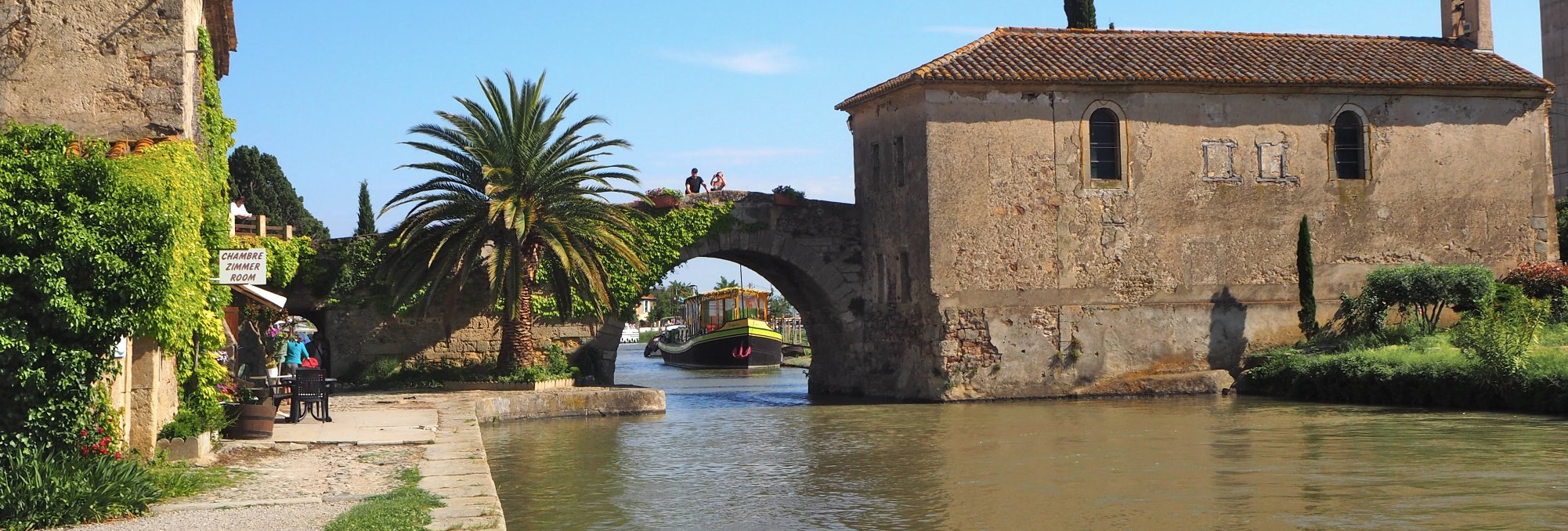
The Canal de Garrone might not be as well known as the Canal du Midi, but it is enjoyable, quieter and you can cruise it on a Narrowboat. Text and Photos: Nick Wall

All it takes is a flick of the wrist - passing through locks could hardly be easier. Forget winding stiff paddles up and down and putting out your back on heavy gates. Just twist the perche a quarter of a turn, wait for the lights to turn green, the gates to open and then just cruise in. A press of the green button on the lockside control panel does the rest.
Think boating on the canals in the south of France and the chances are you’ll picture the Canal du Midi- quite rightly too, it’s a lovely waterway full of character. But, like the Llangollen, it can get busy, especially in the height of the holiday season. The Canal de Garonne does not - which is one reason why we’re at Meilhan-sur-Garonne, an hour or so south-east of Bordeaux.
Another reason is to experience the French canals - something I’ve always wanted to do but, as with many things, never quite got around to. The opening of Minervois Cruisers new base at Meilhan this year provided a good opportunity to find out more - and I wanted to a do it on a narrowboat.
The canal basin here is everything France should be - attractive and peaceful, partly because the typically sleepy small French town is perched high on a bluff above the canal (the views from there are superb), and also because there’s little water traffic and few moored boats to disturb daily life. It’s a good place to start a cruise southwards to discover a different part of the French canals.
As it heads towards Toulouse to link with the Canal du Midi, not surprisingly the canal (until recently known as the Canal lateral a la Garonne) pretty much parallels the river from which it takes its name; it was completed in 1856 so that commercial barges heading north of Toulouse between the Med and the Atlantic didn’t have to cope with the vagaries of the river and the risks of floods and grounding as they plied their trade. Nowadays, as with the Canal du Midi, it’s mainly used for leisure and for yachts and boats transiting between the two seas (the two canals linking Bordeaux to Sete are jointly known as Le Canal des Deux Mers) but its commercial heritage is apparent as soon as you head out from the basin. At 18 metres wide (narrower under some bridges) the canal is broad enough to wind our 49ft boat if we wanted to, but we don’t because our destination is Le Pont-Canal d’Agen one of the finest aqueducts in France. lt’s a relaxing three days and 68km away, with 14 locks, a few pounds and a small aqueduct along the way.
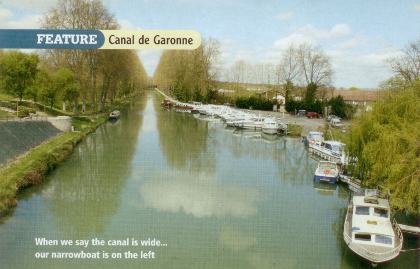
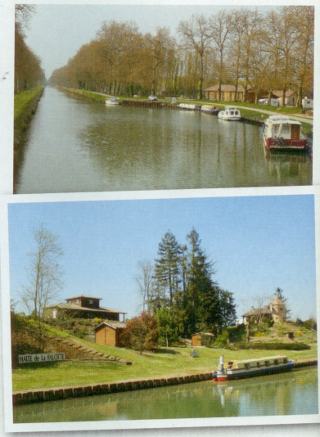
Cruising on this canal is certainly different, particularly in a narrowboat; its broad width and long straights make the 8kph speed limit (a fraction under 5mph) seem slower than it actually is; in some respects it’s rather like the Shropshire Union mainline without the cuttings and embankments. Much like the Canal du Midi, it produces that strange, almost timeless feeling as you seem to drift between the phalanxes of poplars that parade along the banks of the Marmandais plain.
Despite the width of the canal and its depth of around 1.5 metres (5ft), it’s important to stick to the speed limit. Quite apart from risking a fine, the banks are sometimes fragile, so much so that loose concrete panels have been used to protect them in places; one boat skippered by a German powered along so quickly he left the sound of concrete castanets in his wake - the damage he was potentially doing was shameful.
Charting your progress is as easy as at home; a copy of the Fluvial cruising guide does the job of a Nicholson’s and the bridges usually have names and carry a PK (pointe kilometre) sign giving your distance almost down to the metre, so you know exactly where you are and how far to the next lock or mooring place. Knowing the distance to the next stop is useful because, unlike British canals, stopping along the towpath isn’t always that easy; the roots from the trees reach down into the water making mooring tricky and risking a prop ding. That’s no great hardship though because there are plenty of places to rest up; the ports de plaisance have the usual facilities you would expect in a marina (expect to pay around €4 a night), while the haltes nautiques tend to be pontoons or quays with limited facilities, but usually, and essentially, a bar! While you won’t find a Tesco there are plenty of mini-supermarkets and shops in the villages along the way to stock up with food, and this being France, the quality is excellent. One of these stops is five kilometres down the canal at the village of Fourques sur Garonne.
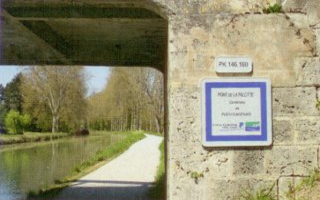
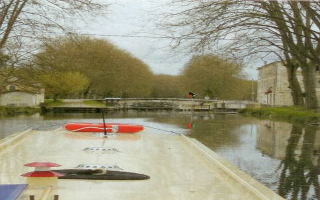
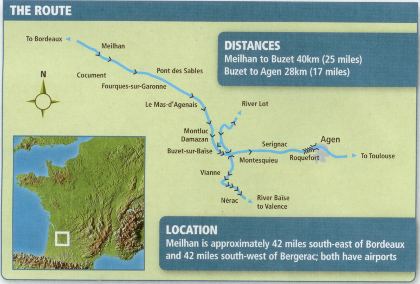 Hop off the boat to stretch your legs and you find a stone
monument alongside the towpath that recalls a famous steam barge explosion in 1908 when all
five people on board were killed; far from being morbid it’s an interesting reminder of this
canal’s previous life as an important commercial waterway.
Hop off the boat to stretch your legs and you find a stone
monument alongside the towpath that recalls a famous steam barge explosion in 1908 when all
five people on board were killed; far from being morbid it’s an interesting reminder of this
canal’s previous life as an important commercial waterway.
There is other evidence of this past - large barges lurk occasionally along the canalside reminding you why the canal is so wide, plus there’s the odd industrial building gradually decaying into history by the water’s edge. Of course, the French do history well when it comes to buildings. At the pretty, once-fortified village of Damazan, one of the recommended stops, the buildings are a parade of attractive multi-coloured façades that have to be maintained in their original colours by law to keep the town’s character.
A little further along and perched on a terrace overlooking the river, is Le Mas d’Agenais, a halt for pilgrims on the road to the shrine of Saint-Jacques de Compostelle. While it’s not a classically pretty French village, it has shops that are particularly useful for stocking up the boat if you need to. But the ace up its sleeve is the Rembrandt, one of fewer than 50 that survive, in the Romanesque church. It was left to the church in a 19th century bequest and hidden away, unknown and unappreciated for many years.
On the towpath close to the hire-boat yard there there’s also a strange series of concrete troughs with iron rings which, CB’s historian Hugh McKnight says are very rare on canals in any part of the world. They are presumed to be boat horse drinking troughs from the Second World War when horses made a big comeback during due to lack of fuel.
Reaching Buzet-sur-Baise after nine hours cruising and seven locks there’s a choice to be made, and the clue is in the name: you can either turn off left and descend through a double lock onto the twistier environs of the River Baise and head further into the Lot for a few days, or continue along the canal to Agen and its spectacular aqueduct.
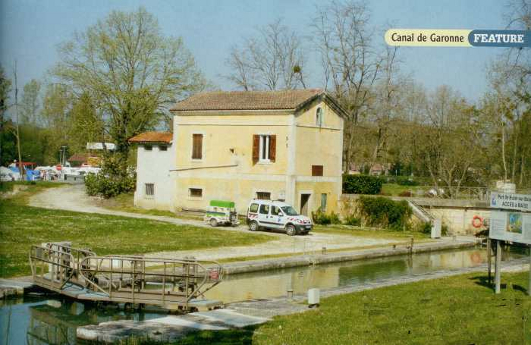

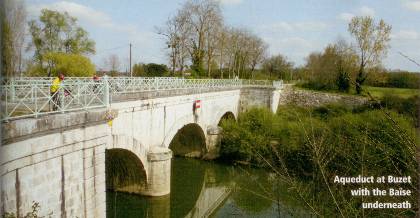
Buzet itself is a perfect overnight stopping place. There’s plenty going on, good facilities and a range of places to eat; the Auberge du Goujon (www.aubergedugoujon) wouldn’t be out of place in Paris and its excellent mainly fish menu is reasonably priced. Plus, the area is a wine centre of some repute and a tasting is not to be missed - this is France, after all.
For those interested in history, a short taxi ride from Buzet is the bastide of Vianne which provides a history-book image of what fortified towns should really look like. Great stone towered gates are linked by 26ft-high walls that protectively enfold the llth to 14th century houses and churches. It’s also a world-renowned glass-making centre and well worth taking time out to visit. Shortly after Buzet, two locks connected by a short pound lift the canal onto a small aqueduct where the Baise swings underneath and heads off to the west. The whole thing is automatic after you’ve entered the first lock. At the top lock there’s a picture-book lock-keeper’s cottage (one of the few that are occupied) and it’s one of the prettiest on this part of the canal.
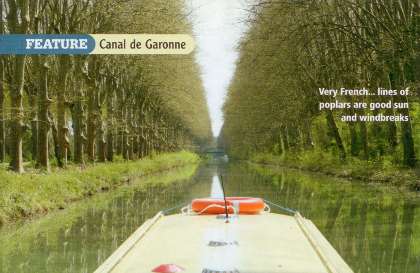
|
The Locks – Les Ecluses |
|---|
|
Mostly they are semi-automatic without lock-keepers, but they are simple to use. A hundred metres or so before the lock a perche (pole) dangles above the canal at boat height; as you reach it you twist it a quarter of a turn which triggers a switch to set the process in motion. The lock will then prepare itself (emptying if necessary) while 'traffic' lights (feu d’acces) remain red. Once the lock is ready the lights turn green and the gates open. Then it's just a simple case of motoring into the lock, dropping off a crew member on the landing stage at the lock entrance if necessary. On the lockside a control cabin has green and red buttons; simply press the green button and everything starts to happen; if there’s a problem, you hit the big friendly red button and it all stops. The flow of water starts off slowly, lifting the paddles part way as you would expect and then opening them fully. After it has filled or emptied and the gates have opened, you have three minutes to exit before the gates close again. There are cills but you're unlikely to see them as they are well under the water even when the lock has emptied, so the chances of cilling are remote. If a lock doesn't work properly, there’s an intercom on the control panel to call for help; the one time we used it when the lower gates didn’t shut fully, a quick call produced a VNF (Voies Navigables de France) lock-keeper within ten minutes who cheerfully sorted the problem. |
|
The Boat |
|---|
|
We took a Midi-Explorer Four narrowboat from Minervois Cruisers which opened a new base at Meilhan this year. It's very ably run day-to-day by Mike and Kath Ricketts who live on their 60ft narrowboat Kinsarvik and whose knowledge of the French canals (and canals in general) is terrific - they spent two seasons cruising in France before settling down at Meilhan. They provide the usual service of making sure you are happy with the boat and the waterway before you leave, and usually take you through the first lock to demonstrate the operation. The Midi-Explorers are Colecraft shells and just like any narrowboat. They differ slightly with built-in seating around the well deck and all waste, as is the custom, goes straight into the canal, but waste tanks have been included for potential future use. The boats have all the usual facilities, including central heating for the cooler months. Because they are a fraction under 15 metres (49ft), you don't need a French boating licence. They can sleep six, though four or five is more comfortable and the configuration can be suited to the party; we used a double, two singles and one on the double dinette. Costs for four for a week range from £749 up to £1464 in the peak season. For more information, go to www.minervoiscruisers.com |
The run in to Agen is fairly straight and parallels the A62, but before it is the village of Serignac, another good stopping place with a church that has an octagonal base and very unusual helicoidal clocher (bell tower). From Serignac it’s just 11km to the foot of the Agen flight of four. The locks lift you up through neatly landscaped pounds to what was for me the highlight of the trip, the aqueduct.
Built over nearly ten years and completed in1849, 23 arches, each spanning 20 metres, stride across the river Garonne. When it was completed it was the longest navigable aqueduct in France at 539 metres. Its width of 8.82 metres (with a towpath on either side) means that there has to be a one-way system, but there are traffic lights and basins at either end to avoid mid-section stand-offs. A look over the side at the river which was in flood during our visit and you can see why they built the canal....
The hustle and bustle of Agen (the capital of prunes no less) comes as something of a shock after three peaceful days drifting through the French countryside, but it’s worth the stop - curiously, the station café (Buffet de la Gare) is one of the best places for lunch; the food is excellent and you can understand why it was recommended by Rick Stein in his French Odyssey.
With only a week to play with, Agen is the place to turn around and then it’s simply a case of retracing your steps to Meilhan, stopping en route at the places you perhaps missed the first time around or simply because you want to stop there again. This time you’re going ‘downhill’ and if anything it’s even easier.
So what to make of cruising this canal? lt’s easy and relaxing, the locks are simple, you can go onto the Baise for a few days of variety and there’s plenty to see and do. It’s nice to do it on a narrowboat, too - the French people walking and cycling along the towpath (part of the voie verte or Green Way and excellently maintained, BW take note!) didn’t seem too sure what to make of these strange English boats, but were always keen to shout bonjour and wave. Plus, of course, the weather is usually perfect for boating, it’s quiet and the locks are a pleasure.
It’s certainly different to boating in the UK and it makes a pleasant change.

